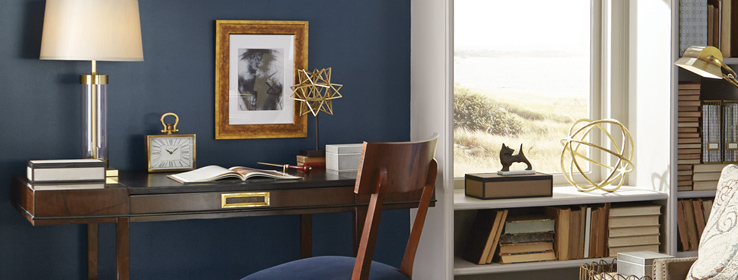Equal parts exotic and familiar, indigo is a rich, worldly blue with an appeal that stretches back through centuries. Here’s a (re)introduction, plus tips from Sue Wadden on how to use indigo in any room.
By Amanda Lecky
Weavers from Mexico to Mali have used indigo dye for 4,000 years — but how the first dyers discovered that certain green leaves produce a rich blue pigment remains a mystery. It’s mysteries like these that drew author Catherine Legrand to study indigo and understand its history. In her book, Indigo: The Color That Changed the World (Thames & Hudson, 2013), Legrand unravels a bit of indigo’s enigmatic past and shares how it became one of the most beloved colors across countless cultures.
After the first dyers discovered indigo, a simple process to create indigo dye was formed: Soak the leaves in water to extract the color, treat with stabilizers, dry and pulverize into a powder, and finally mix with other ingredients to create the familiar blue dye.
From those simple beginnings, indigo became such a treasured commodity it was sometimes known as “blue gold.” By the end of the 19th century, production of natural indigo dye was at an all-time high, with plantation-scale operations and nearly 3,000 square miles of land, mostly in India, devoted to producing 19,000 tons of indigo per year. But in 1897, advances in organic chemistry had replaced natural indigo dye with a synthetic version. By 1914, the manufacturing of plant-based indigo had decreased to just 1,000 tons per year. Still, enthusiasm for indigo remained vibrant, even into the modern era: In 2002, 17,000 tons of synthetic indigo were produced worldwide.
How is all this indigo used? “For everything from dying fabric to leather to hair,” Legrand says. American blue jeans, Japanese kimonos, Chinese batik and Indian block prints all have one color in common: indigo. And indigo is not just for fabric. “Natural indigo carries the reputation of being an insect repellent, so it is used in Japan to dye mosquito nets. And in the south of France, for the same reasons, shutters, doors and carriages were painted in what was called bleu charrette, made from the pigment left over in the indigo vat mixed with lime,” Legrand says.
Of course, there’s no way to know exactly why the color of indigo is so appealing, but people worldwide tend to be partial to blues of all types. “It’s the color of the sky and the sea, and it’s rare in flora and fauna, which may explain why we value the color so much,” says Sue Wadden, director of color marketing for Sherwin-Williams.
Indigo is a great choice for interior walls, says Wadden, but using such a bold color can take a bit of finesse. “Indigo is so stunning, it needs very little competition,” Wadden says. “Use indigo with whites and yellow-based neutrals. If you want more energy, mix it with pops of red or orange. Or use it to anchor other, paler, watery blues.”
Paired with crisp white, indigo can help create a traditional New England look or, in a flat finish with washed woods, a Scandinavian effect, Wadden says. Choose from a wide range of indigo options in the Sherwin-Williams palette, or pick one of Wadden’s favorites: Indigo (SW 6531), “a bright, clean, saturated, energetic blue”; Indigo Batik (SW 7602), “a moodier, more traditional, washed-out shade”; or Gale Force (SW 7605), “inky, with a slight yellow undertone that almost looks time-worn.” Whichever you choose, you and your clients will feel right at home with history’s most beloved color.













